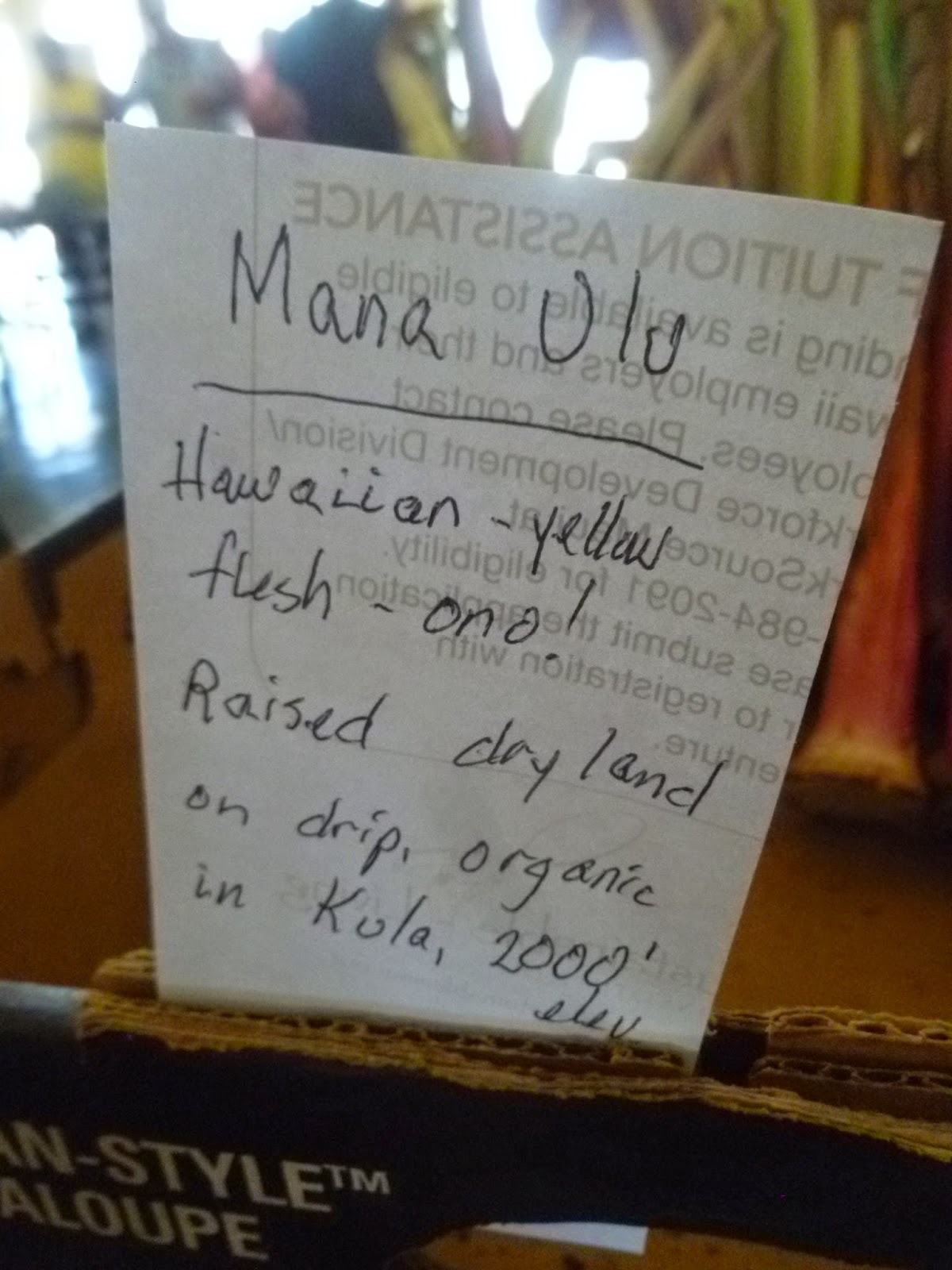Six
reasons to go to the Maui Seed and Plant Exchange
 |
| Organic Farmer Gerry Ross of Kupaá Farms with the Mana Ulu taro variety. |
For a
gardener, visiting a well-run local seed swap is like winning a jackpot. If you
have a green thumb or have ever harbored the slightest hope of turning your
brown thumb green, the upcoming Maui Seed and Plant Exchange is worth your
time. And it’s free! It will be held on Sunday, October 26th from 1
– 4 pm at the Hawaiian Canoe Club hale, Hoaloha Park on Kaahumanu Avenue,
across from the Maui Mall in Kahului.
The seed
swap in June was amazing. Organized by Maui Seed Savers founders Evan and Elan, the seed swap tables were piled with seed packets, bags of seeds, leaves, roots and stems. Plants that
you’ve never heard of were there. Plants that are harder to get were there. Plants
that other people have successfully grown on Maui were there.
By the
way, if you don’t have any seeds or plants to share, you are still highly encouraged
to come to the event. If you have seeds or plants to share, please bring them,
but if you don’t, it’s better for you to attend if you’re interested instead of
staying at home because you feel you are not contributing. You can always share in the future when you
are able.
That’s
part of the point of having a seed swap and plant exchange. It’s not just to
trade seeds and get free seeds. It’s to find out what grows on Maui.
So six reasons to attend the Maui Seed and Plant Exchange.
1. Free stuff
Woo hoo! Getting free stuff appeals to one’s inner
freeloader. It’s always nice to get free things and to give things, not only
because it saves money but it creates community and connections. You can pay to
buy seeds, but it’s not the same as getting free seeds from someone who you
have met and has a connection to that plant.
2. Save time and effort
You can buy packets of zucchini seeds but they may not
grow that well on Maui, or not that well in your particular micro climate on
Maui. You might be at the wrong elevation, or have the wrong soil, or have too
much wind, or too much dampness to have success with that particular zucchini
variety. You could perhaps buy 10 zucchini varieties and maybe one of them will
actually grow and produce zucchini, but it’s trial and error. Going to a seed
swap gives you a chance to obtain seeds of plants that have grown successfully
on Maui. At the June swap, there was a huge bag of corn seeds of a variety
developed by UH Manoa, specifically for Hawaii soils and conditions. I have had
a terrible experience with growing corn here. My plants got about a foot high
and then keeled, due to the mosaic virus in the soil. Some people have had
success growing mainland corn varieties from some random seed packet bought at
Walmart or Home Depot, but most of us have torn out our hair.
3. Variety
The variety of plants at the seed exchange is amazing.
Herbs you’ve never heard of, or that may require research to obtain, like the
moringa tree or epazote, an herb used to make beans more digestible, and save
your friends and family from your sneaky gas attacks. Or heirloom varieties of
sugar cane or different varieties of taro, the treasured local Hawaiian starchy
vegetable. You won’t find some of these
varieties at the local nursery or hardware store. Also, you are contributing to
genetic variety by saving seeds and planting different varieties, not just the
few that are commonly available.
Why is genetic
variety important?
Long story short, having a lot of
genetic variety for one plant species or crop provides greater resilience and
adaptability to changes in the environment, bugs, diseases, and human needs.
Protecting genetic variety is crucial to supporting local agriculture that can
feed an island.
4. Education
Going to the plant and seed swap is educational. You’ll
learn how to grow different plants and tips on what not to do. The volunteers
in June were all farmers or gardeners so you could ask them random gardening
questions too, even if they weren’t related to the seeds or plants on the
table.
5. Preserve local culture and heritage.
By cultivating plants that are valued by the native
Hawaiians or other ethnic cultures on Maui, you help preserve local history and
heritage. Taro, sweet potatoes, bananas, chayote squash, moringa, mamaki, breadfruit,
and sugar cane have cultural significance in Hawaii. There are more varieties than the ones that are commonly available, and each variety may have different culinary features or uses.
6. Food Security
In one of those zombie apocalypse scenarios where there
are no boats to Hawaii bringing supplies of toilet paper, coal, and food (with
TP being the most important item, just kidding), being able to grow local food
crops that can withstand Maui’s unique growing conditions is going to be part
of human survival. Maybe it will never happen, but what if? Even if life is
still normal, you get to part of promoting local food security by growing your
own food and saving seeds and plants that grow well locally.
Lastly, you should go because I am traveling off-island
and cannot attend the next seed swap. Let me know how it is!





















No comments:
Post a Comment
Comments are important to me, so mahalo for adding a comment! I will try to follow up when I receive one.